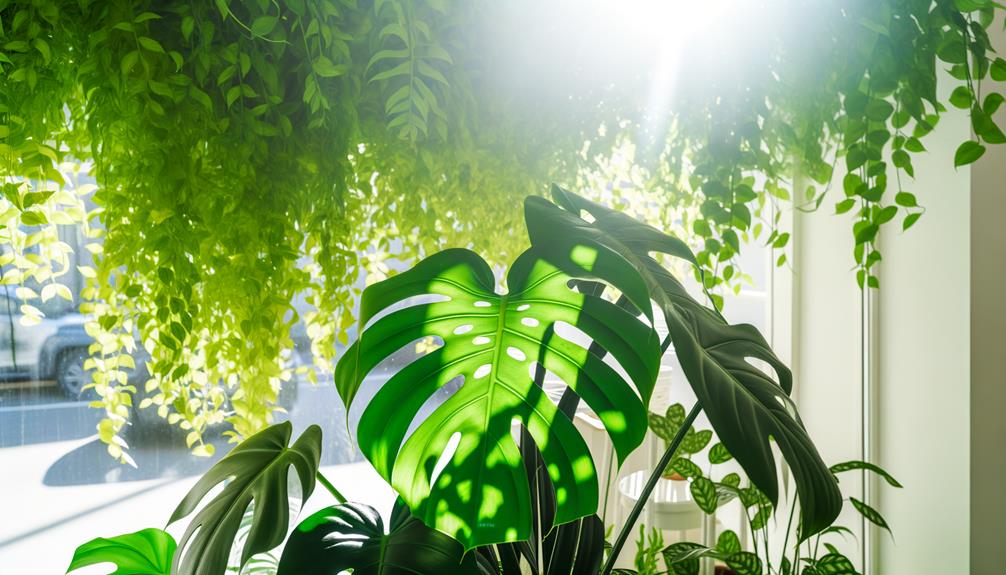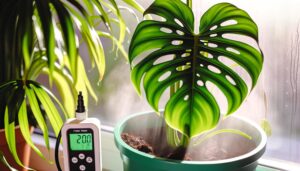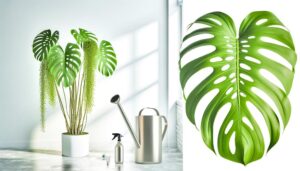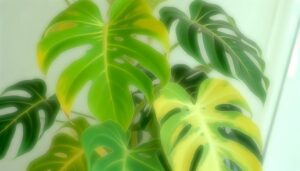Monstera Acacoyaguensis Light Requirements
Monstera acacoyaguensis thrives in bright, indirect sunlight, reminiscent of its native tropical rainforest understory. Provide photosynthetically active radiation (PAR) levels of 100-200 µmol/m²/s to optimize photosynthesis while preventing chlorophyll degradation.
Utilize sheer curtains or place the plant near north/east-facing windows to filter intense light and avoid photoinhibition and leaf scorch. Adjust light exposure seasonally and watch for etiolation, pale leaves, or scorching as indicators of insufficient or excessive light.
Implement artificial lighting with a light intensity of 200-400 µmol/m²/s and a 5000K-6500K color temperature to supplement natural light, ensuring a 12-14 hour photoperiod. Explore more for detailed care.

Key Takeaways
- Monstera acacoyaguensis thrives in bright, indirect sunlight, avoiding direct light to prevent leaf burn.
- Maintain photosynthetically active radiation (PAR) between 100-200 µmol/m²/s for optimal growth.
- Mimic native habitat conditions using sheer curtains or north/east-facing windows to filter intense light.
- Rotate the plant regularly to ensure even light distribution and symmetrical growth.
- Use artificial lighting with 5000K-6500K color temperature to supplement natural light if necessary.
Natural Habitat Insight
The Monstera acacoyaguensis thrives in the humid, shaded understory of Central American tropical rainforests, particularly in regions with consistent moisture and dappled sunlight. You'll find this species in environments where the canopy offers partial protection from direct solar radiation, maintaining lower light intensity.
The microclimate is characterized by high relative humidity, often exceeding 70%, which is essential for its physiological processes. The soil is typically rich in organic matter, ensuring adequate nutrient availability and excellent drainage.
Epiphytic growth patterns are common, with aerial roots assisting in nutrient absorption from both soil and air. This habitat promotes the plant's vigorous growth, fenestrated leaf morphology, and overall health, creating an ideal setting for studying its natural light requirements.
Ideal Light Conditions
To replicate the most suitable light conditions for Monstera acacoyaguensis, you should provide bright, indirect sunlight, mimicking the dappled light of its native understory habitat. This plant thrives under conditions where photosynthetically active radiation (PAR) is between 100-200 µmol/m²/s.
Utilize sheer curtains or position the plant near east- or north-facing windows to filter intense light. Avoid placing it in low-light environments, as insufficient light can hinder chlorophyll synthesis, leading to etiolation and compromised foliar morphology. Conversely, excessive light can cause photoinhibition, resulting in leaf burn and chlorophyll degradation.
Direct Vs. Indirect Light
When positioning your Monstera Acacoyaguensis, consider the impacts of direct light, which can cause photodamage and lead to chlorophyll degradation.
Instead, aim for ideal indirect lighting that provides sufficient photosynthetically active radiation without the risk of leaf burn.
This balance guarantees strong growth and colorful foliage.
Direct Light Impacts
Assessing the light requirements of Monstera Acacoyaguensis is crucial for understanding how direct sunlight can harm the plant, while indirect light offers ideal conditions for photosynthesis. Direct light exposure can lead to photodamage, causing leaf chlorosis and necrosis due to excessive UV radiation. The plant's sensitive chlorophyll molecules can degrade under intense light, resulting in damage to the photosynthetic apparatus. Signs of this damage include brown, crispy patches on the foliage indicating cellular damage. In contrast, indirect light diffuses photons, allowing for optimal chloroplast function without the risk of overheating. This balance supports efficient carbon fixation and overall plant health. Therefore, avoiding direct light is essential for maintaining the structural integrity and physiological processes of Monstera Acacoyaguensis.
Optimal Indirect Lighting
Understanding the differential impacts of direct versus indirect light is essential for maximizing the growth conditions of Monstera Acacoyaguensis. You need to make sure your plant receives ideal indirect lighting to prevent photosynthetic stress and leaf burn. Direct sunlight can cause chlorophyll degradation, while indirect light facilitates efficient photosynthesis without harming the foliage.
| Aspect | Direct Light |
|---|---|
| Photosynthesis Rate | High but risk of photoinhibition |
| Leaf Health | Potential for chlorosis and necrosis |
| Growth Pattern | Stunted growth with potential leaf burn |
Placing your Monstera near a north-facing window or using sheer curtains to diffuse light will create an excellent environment. This guarantees the plant's photosynthetic machinery operates effectively, promoting strong growth and colorful foliage.
Seasonal Light Changes
You must consider the photoperiod and light intensity variations when caring for Monstera Acacoyaguensis throughout different seasons. During winter, the plant's reduced photosynthetic activity necessitates supplemental lighting to compensate for shorter days.
Conversely, in summer, you should implement shading strategies to mitigate the risks of photoinhibition and leaf scorching due to increased solar irradiance.
Winter Light Needs
During winter, Monstera acacoyaguensis needs careful monitoring of light exposure to guarantee it receives sufficient intensity despite shorter daylight hours. You must make sure it gets at least 6 hours of indirect sunlight daily.
To enhance light conditions:
- Utilize artificial grow lights: LED grow lights can supplement natural light, maintaining photosynthesis efficiency.
- Position near south-facing windows: South-facing exposures maximize light capture during diminished daylight periods.
- Regularly clean leaves: Dust accumulation can interfere with light absorption, hence reducing photosynthetic capacity.
Monitor photoperiod changes and adjust the lighting regimen accordingly. Insufficient light can lead to etiolation, where the plant becomes leggy and weak.
Summer Light Adjustments
Summer light adjustments for Monstera acacoyaguensis involve reducing the intensity of direct sunlight to prevent leaf scorch and maximize photosynthetic activity. You should consider relocating the plant to a spot with filtered light or using sheer curtains to diffuse sunlight. Monitoring the leaf surface temperature is essential, as excessive heat can cause cellular damage. Utilizing a light meter to measure lumens guarantees ideal light levels. Aim for consistent indirect light to facilitate chlorophyll synthesis without causing photoinhibition.
| Light Condition | Recommended Action | Benefits |
|---|---|---|
| Direct Sunlight | Use sheer curtains | Prevents leaf scorch |
| Filtered Light | Maintain current position | Enhances photosynthetic efficiency |
| High Temperature | Monitor leaf surface temperature | Avoids cellular damage |
| Lumens Measurement | Use light meter | Ensures ideal light levels |
| Indirect Light | Consistent exposure | Facilitates chlorophyll synthesis |
Signs of Too Much Light
One clear indicator of excessive light exposure in Monstera acacoyaguensis is the presence of leaf scorch, characterized by brown, crispy edges and tips. This photodamage results from photoinhibition, where chlorophyll fails to dissipate excess light energy.
High light intensity can lead to:
- Chlorosis: Leaves exhibit yellowing due to chlorophyll degradation.
- Necrosis: Brown patches form as cells die from extreme light stress.
- Leaf curling: Edges curl inward, a protective response to minimize surface area exposed to light.
Monitoring these symptoms can help you adjust light conditions to prevent further damage. Ensure that your Monstera acacoyaguensis receives indirect, filtered light to maintain peak physiological and morphological health, avoiding the detrimental effects of phototoxicity.
Signs of Insufficient Light
Inadequate light exposure in Monstera acacoyaguensis can lead to etiolation, where the plant exhibits elongated stems and pale, undersized leaves due to insufficient photosynthetic activity. You'll notice the internodes—spaces between leaf nodes—become abnormally long, resulting in a leggy appearance.
Chlorophyll production diminishes, causing leaves to lose their vibrant green color and appear washed out. Additionally, leaf fenestrations, the characteristic splits and holes, may be absent or significantly reduced.
Growth rates slow down as the plant prioritizes stem elongation over leaf development. If left unaddressed, these symptoms can compromise the plant's overall health, making it more susceptible to pathogens and pests.
Make sure your Monstera receives adequate light to maintain its structural integrity and vibrant foliage.
Using Artificial Lighting
Employing artificial lighting can effectively supplement natural light, guaranteeing your Monstera acacoyaguensis receives the best light spectrum for robust growth and development. Utilize full-spectrum LED grow lights, which mimic natural sunlight and provide essential wavelengths for photosynthesis.
Here are three critical parameters to ponder:
- Light Intensity: Aim for 200-400 micromoles per square meter per second (µmol/m²/s) to optimize photosynthetic efficiency.
- Photoperiod: Maintain a consistent 12 to 14-hour light cycle to replicate equatorial daylight patterns.
- Color Temperature: Select lights with a color temperature between 5000K and 6500K to guarantee a balanced spectrum that supports both vegetative growth and flowering.
Adjusting Light for Growth
To enhance the growth of your Monstera acacoyaguensis, precisely adjusting the intensity and duration of light exposure is crucial for promoting healthy foliage and robust development.
Guarantee the plant receives bright, indirect light for approximately 10-12 hours daily. Utilize a light meter to measure the intensity, aiming for 10,000-20,000 lux. If natural light is insufficient, supplement with full-spectrum LED grow lights, keeping them 12-24 inches away to avoid phototoxicity.
Monitor the plant's response; signs of etiolation indicate insufficient light, while scorched leaves suggest overexposure. Adjust the photoperiod and distance accordingly to achieve optimal photosynthetic activity.
Regularly rotate the plant to guarantee even light distribution, promoting symmetrical growth and reducing phototropic stress.
Conclusion
To sum up, understanding your Monstera acacoyaguensis's light needs is essential for healthy growth. Remember, it's a balancing act—excessive light can scorch its leaves, while inadequate light stunts its growth. Adapting to seasonal changes and using artificial lighting when needed guarantees your plant thrives year-round.
So, don't underestimate the importance of proper illumination; it's the key to transforming your Monstera from surviving to flourishing. Your plant's health depends on this critical element—light.






